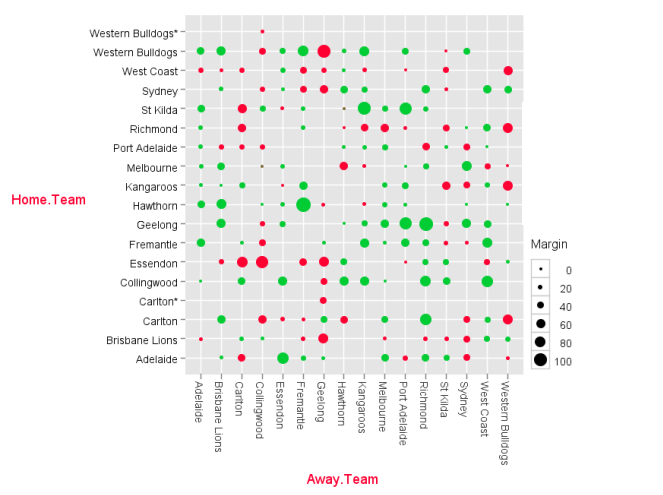A couple of final charts before GF 2.0.
The first chart looks at the history of Grand Finals, again. Each point in the chart reflects four things about the Grand Final to which it pertains:
- The margin of victory (indicated by the point's height)
- The year of the victory (indicated by the vertical displacement of the point)
- The decade of the victory (indicated by the colour of the point)
- Whether the winner was the team from higher or lower on the home-and-away season ladder (indicated by the point's shape, with triangles indicating a victory by the higher-placed team and circles a victory by the lower-placed team)

A few takeouts from this chart for me:
- Grand Final margins have generally been increasing. Excluding last weekend, only 6 GFs in the past 30 years have finished with a margin under 20 points. There were 8 such GFs (9 if you include the drawn 1977 GF, not shown here) of this type in the preceding 20 years.
- The last decade appears to have reversed this trend. Over half the GFs in this time have finished with a margin under 30 points whereas this was the case for only 1 GF in the previous decade.
- Blowout victories - those where the final margin is 10 goals or more - are almost always a case of the higher ranked team defeating the lower. There's been 12 such GFs and in only one of them has the lower ranked team defeated the higher ranked one.
Two teams played at home twice against the same opponents this season: the Dogs versus Collingwood, and Carlton versus Geelong. To prevent the results of these pairs of games from obscuring one another I've created a second row for the Dogs and the Blues as home teams.
Dots, as well as encoding which team played which, also encode the result. They're green if the home team won, red if they lost and olive (and hard to see) if they drew. Their size denotes the margin of victory.


As usual, a couple of things to get you started in reviewing this chart:
- The preponderance of green over red tells you that home teams won more often than they lost, as they have every year in living memory. This year, however, the dominance was quite slight: home teams won only 58.5% of the time.
- Collingwood had the best home record, lost only one game, to Geelong.
- Geelong lost at home only twice and narrowly on both occasions.
- Hawthorn lost only twice at home too, once to Geelong and once to the Roos
- St Kilda's home record was above average - 7 wins, 1 draw and 2 losses - but it played relatively few games at home this season.
- Carlton had a poor home record, winning 5 and losing 7, but made up for this somewhat with a 6 and 4 away record.
- Hawthorn were quite poor on the road this year, winning only 3 games, drawing 1 and losing 7.
(You might have noticed that the charts in this blog look a little different from those you're used to. That's because I'm using an R package called ggplot2, which I've known to be capable of producing good-looking plots for a while now, but which I also knew took a lot of work to produce. Recent updates of JGR and Deducer, however, have provided a GUI into ggplot2, for which I am enormously grateful.
The R product, and the incredible range of packages that are available for it, all of which are free, is a stunning example of what's good about the web and the open source community. Without the hundreds of people, probably thousands, of people who contribute to this community, there'd be no MAFL models, no MAFL-Online and I, for one, would miss that. So, on the off-chance that someone from that community should zip by this site: thanks.)

No comments:
Post a Comment